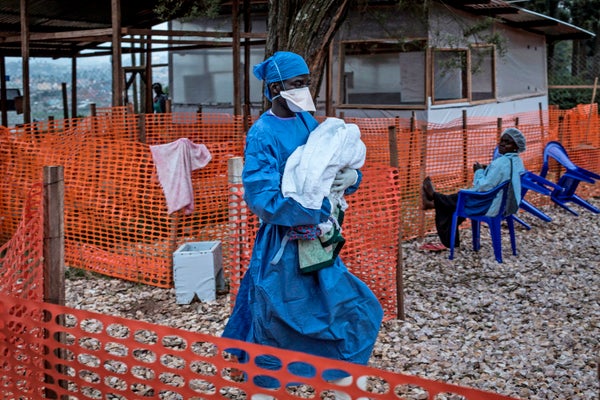August marks the anniversary of the current Ebola outbreak centered in the Democratic Republic of the Congo (DRC). First declared on August 1, 2018, in the nation’s province of North-Kivu, it has sickened more than 2,500 people and killed close to 1,700—making it the second-worst outbreak after the one between 2014 and 2016 in West Africa, which sickened more than 28,000 people and killed more than 11,000.
On July 17 the World Health Organization declared the latest outbreak a public health emergency of international concern—its highest level of alarm. Following this designation, the World Bank released up to $300 million for global response efforts. But despite the availability of funding, vaccines and treatment, people continue to be infected and die from the disease—including in areas where it was once stamped out. It is also now hitting more populous regions; a second confirmed Ebola death has recently been reported in Goma, a city of two million residents and a major travel hub.
“One year after the outbreak, certainly, we didn’t expect it to be still going on,” says Michelle Gayer, director of emergency health at the International Rescue Committee (IRC), a humanitarian organization that has been responding to the outbreak in more than 70 health facilities. “It’s killing more people than it should, despite vaccination and treatments. It’s still going on, and it is affecting more women than previous outbreaks.” Some 57 percent of those infected are women, and about 18 to 20 percent are younger than 18, Gayer says. The outbreak was initially clustered in the north, in cities such as Beni, and then moved farther south, she says. Beni had been free of new cases for some time—but in July or so, more than half of them have been in that city, she adds.
On supporting science journalism
If you're enjoying this article, consider supporting our award-winning journalism by subscribing. By purchasing a subscription you are helping to ensure the future of impactful stories about the discoveries and ideas shaping our world today.
This Ebola outbreak is the first in which a vaccine is being widely used. Made by Merck, the vaccine has not been commercially licensed but is being given under a “compassionate use” protocol, because Ebola is often a fatal disease. Health workers have employed a “ring vaccination” strategy, vaccinating those who have come into contact with people infected with the virus and the contacts of those contacts. The vaccine is 97.5 percent effective. But not everyone can be vaccinated before they get sick, and many people hide their disease because of the stigma, Gayer says.
Violence has roiled the DRC for decades, but Gayer does not think it is directly driving the outbreak’s severity. Health care workers have been killed—not as a result of the country’s ongoing military conflict but rather out of a mistrust of the response and a lack of knowledge about the disease they are battling.
“I think it comes back to one piece, really, which is around community engagement and trust,” Gayer says. “I think that’s probably been the most critical factor.” The problems are an inadequate understanding of what people’s needs are among Ebola responders and a failure to engage with them in the right way, she says. If you have malaria or don’t have clean drinking water, someone telling you to wash your hands or to be careful if you have a fever because you might have Ebola “is very confusing,” Gayer notes. “We want to be making sure that we’re not neglecting children who have pneumonia or women who want to deliver babies” while treating the Ebola outbreak.
Gayer’s IRC colleagues regularly sit down face to face with groups of people in villages and towns affected by the epidemic, she says. They meet with women who want to know what happens if they are pregnant, for example. And they have invited community members to come to their clinics and help design the isolation structures for patients “so they don’t look too scary,” she says. People who have survived Ebola are also getting involved in helping treat patients.
But as new cases continue to crop up, an end to the outbreak remains elusive. “Right now, we can say there are no clear signs of any significant slowing down,” says Chandy John, president of the American Society of Tropical Medicine and Hygiene. He says the emergency declaration and the World Bank’s $300 million will likely help, but more funding and support are needed. “If countries and organizations band together to get the needed funds, I think this epidemic can be contained,” he adds. “On the other hand, the second case in Goma highlights the potential for spread beyond the current areas. So the need for additional work on the ground in all of these areas is urgent.”
Gayer agrees: “I do believe that we will succeed, but it’s going to take a long time,” she says. “And there's no reason why the disease itself doesn’t become endemic in the DRC. And that’s something else that we have to deal with if that were to arise.”
Editor’s Note (8/6/19): This story was edited after posting to correct the figure for the percentage of those infected who are women and descriptions of causes of violence against health care workers.
